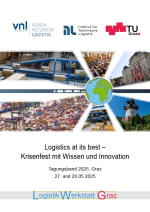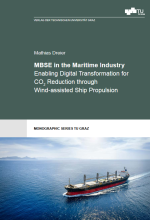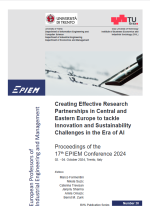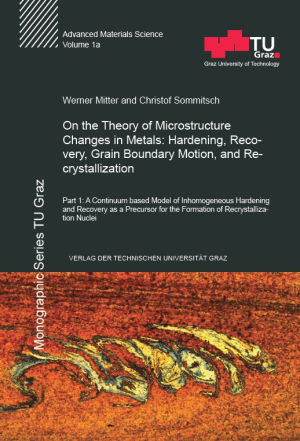Hardening and simultaneously running recovery during and after a deformation are characterized by the dislocation density and the concentration of the point defects (vacancies and interstitials). The change rates of these magnitudes hitherto were calculated using differential equations with the time as the unique independent variable. Therewith these processes only can be described for homogeneous deformation. For generation of recrystallization nuclei, gradients of migration energy of the point defects as a consequence of strain energy and / or rotation gradients are necessary, which only occur with inhomogeneous deformation. Therefore a space dependent deformation rate was introduced to the acquainted simultaneous rate equations of the dislocation density and of the point defects. Taking into consideration all essential structural parameters a detailed and realistic model results suited for calculation of the progress of dislocation density and concentration of the point defects in space and time. From the development of the dislocation density different levels of strain energy can be recognized, which are the precondition for recrystallization nucleation. As in these regions also high gradients of rotation occur, recrystallization nuclei can arise there.
Continuum based Model of Inhomogeneous Hardening and Recovery as a Precursor for the Formation of Recrystallization Nuclei
Ausgabe: kartoniert
ISBN: 978-3-85125-172-2
Umfang: 156 Seiten
Sprache: Englisch
Erschienen: Dezember 2011
Reihe: Monographic Series TU Graz / Advanced Materials Science, Band Vol. 1a
Vergriffen!
Hardening and simultaneously running recovery during and after a deformation are characterized by the dislocation density and the concentration of the point defects (vacancies and interstitials). The change rates of these magnitudes hitherto were calculated using differential equations with the time as the unique independent variable. Therewith these processes only can be described for homogeneous deformation. For generation of recrystallization nuclei, gradients of migration energy of the point defects as a consequence of strain energy and / or rotation gradients are necessary, which only occur with inhomogeneous deformation. Therefore a space dependent deformation rate was introduced to the acquainted simultaneous rate equations of the dislocation density and of the point defects. Taking into consideration all essential structural parameters a detailed and realistic model results suited for calculation of the progress of dislocation density and concentration of the point defects in space and time. From the development of the dislocation density different levels of strain energy can be recognized, which are the precondition for recrystallization nucleation. As in these regions also high gradients of rotation occur, recrystallization nuclei can arise there.
Das könnte Sie auch interessieren
-

Domenik Kaever, Christian Landschützer (Hrsg.)
Logistics at its best – Krisenfest mit Wissen und Innovation
OPEN ACCESS E-BOOK
Read more
MBSE in the Maritime Industry
€ 36.00 Add to cart
MBSE in the Maritime Industry
OPEN ACCESS E-BOOK
Read more
Marco Formentini, Nikola Suzic, Caterina Trevisan, Janpriy Sharma, Amila Omazic, Bernd Markus Zunk (Hrsg.)
Creating Effective Research Partnerships in Central and Eastern Europe to tackle Innovation and Sustainability Challenges in the Era of AI
OPEN ACCESS E-BOOK
Read more
- Gesamtverzeichnis
- Neuerscheinungen
-
Open-Access-Publikationen

- Multimediale E-Books
-
Reihen
- Akademische Reden an der Technischen Universität Graz
- Arbeitshilfen für die Praxis
- Archiv und Bibliothek
- Betonkolloquium
- Buddhist Architecture in the Western Himalayas
- BWL Schriftenreihe
- Electrical Power Systems
- Fachbücher Planung und Bau
- Facts & Figures
- Festschriften TU Graz
- Forschungsreihe IBBW
- Forum Technik und Gesellschaft
- Geodesy
- Immersive Learning Research Network Conference; Workshop, short papers, poster
- Institut für Gebäudelehre Jahrbuch
- International Brain-Computer Interface (BCI) Meeting
- LM.VM.2014
- Logistik Werkstatt Graz
- Materialien zu Schwerpunkten am Institut für Gebäudelehre
- Mathematical Modelling of Weld Phenomena
- Monographic Series TU Graz
- Monographic Series TU Graz|Advanced Materials Science
- Monographic Series TU Graz|Computation in Engineering and Science
- Monographic Series TU Graz|Production Science and Management
- Monographic Series TU Graz|Railway Research
- Monographic Series TU Graz|Reihe Fahrzeugtechnik
- Monographic Series TU Graz|Schriftenreihe des Instituts Betonbau
- Monographic Series TU Graz|Structural Analysis
- Monographic Series TU Graz|Techno- und sozioökonomisch orientierte Betriebswirtschaft
- Monographic Series TU Graz|Technoökonomie und industrielles Management
- Monographic Series TU Graz|Timber Engineering & Technology
- November Talks
- Proceedings of the International Brain-Computer Interface
- Schriftenreihe des Instituts für Baubetrieb und Bauwirtschaft
- Schriftenreihe des Instituts für Straßen- und Verkehrswesen
- Schriftenreihe des Instituts für Wohnbau der TU Graz
- Schriftenreihe zur Wasserwirtschaft
- Science, Technology and Society online
- Seminarreihe Bauunternehmensführung
- Studien zur Architektur | TU Graz
- Textbook Series
- Transform Industry: Guiding the transformation of SMEs
- TU Graz Jahresbericht | Annual report
- TU Graz people
- TU Graz Research
- VKM-THD Mitteilungen; IVT-Mitteilungen ab Bd. 100
- Publizierende von A-Z
- Angebote
Kontakt
Verlag der
Technischen Universität Graz
Technikerstraße 4
8010 Graz, Österreich
UID(VAT) ATU 57477929
Kontaktperson
Gabriele Groß
Tel.: +43(0)316 873 6157
E-Mail: verlag [ at ] tugraz.at
Datenschutzübersicht
Notwendige Cookies sind für die ordnungsgemäße Funktion der Website unbedingt erforderlich. Diese Cookies stellen anonym grundlegende Funktionen und Sicherheitsfunktionen der Website sicher.
| Cookie | Dauer | Beschreibung |
|---|---|---|
| cookielawinfo-checkbox-analytics | 11 Monate | Dieses Cookie wird vom GDPR Cookie Consent Plugin gesetzt. Das Cookie wird verwendet, um die Zustimmung des Benutzers für die Cookies in der Kategorie „Analytics“ zu speichern. |
| cookielawinfo-checkbox-functional | 11 Monate | Das Cookie wird durch die DSGVO-Cookie-Zustimmung gesetzt, um die Zustimmung des Benutzers für die Cookies in der Kategorie "Funktional" zu erfassen. |
| cookielawinfo-checkbox-necessary | 11 Monate | Dieses Cookie wird vom GDPR Cookie Consent Plugin gesetzt. Die Cookies werden verwendet, um die Zustimmung des Benutzers für die Cookies in der Kategorie „Notwendig“ zu speichern. |
| qtrans_front_language | 1 Jahr | Dieses Cookie wird vom qTranslate WordPress-Plugin gesetzt. Das Cookie wird verwendet, um die bevorzugte Sprache des Besuchers zu verwalten. |
| viewed_cookie_policy | 11 Monate | Das Cookie wird vom Plugin GDPR Cookie Consent gesetzt und wird verwendet, um zu speichern, ob der Benutzer der Verwendung von Cookies zugestimmt hat oder nicht. Es werden keine personenbezogenen Daten gespeichert. |
| woocommerce_cart_hash | session | Dieses Cookie wird von WooCommerce gesetzt. Das Cookie hilft WooCommerce dabei, festzustellen, wann sich der Inhalt/die Daten des Warenkorbs ändert. |
Analyse-Cookies werden verwendet, um zu verstehen, wie Besucher mit der Website interagieren. Diese Cookies helfen dabei, Informationen zu Metriken wie Anzahl der Besucher, Absprungrate, Verkehrsquelle usw. bereitzustellen.
| Cookie | Dauer | Beschreibung |
|---|---|---|
| _pk_id | 1 Jahr 27 Tage | Erforderlich für den Betrieb von Matomo, einem Analysetool, das das Nutzerverhalten verfolgt und analysiert. |
| _pk_ref | 13 Monate | Erforderlich für den Betrieb von Matomo, einem Analysetool, das das Nutzerverhalten verfolgt und analysiert. |
| _pk_ses | 30 Minuten | Erforderlich für den Betrieb von Matomo, einem Analysetool, das das Nutzerverhalten verfolgt und analysiert. |
Andere nicht kategorisierte Cookies sind diejenigen, die analysiert werden und noch nicht in eine Kategorie eingeordnet wurden.
| Cookie | Dauer | Beschreibung |
|---|---|---|
| yt-remote-connected-devices | niemals | Speichert die Benutzereinstellungen beim Abruf eines auf anderen Webseiten integrierten Youtube-Videos |
| yt-remote-device-id | niemals | Speichert die Benutzereinstellungen beim Abruf eines auf anderen Webseiten integrierten Youtube-Videos |


